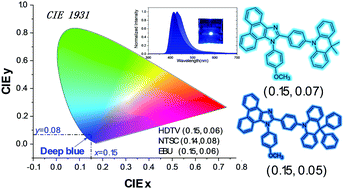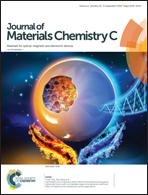Efficient deep blue electroluminescence with CIEy ∈ (0.05–0.07) from phenanthroimidazole–acridine derivative hybrid fluorophores†
Abstract
Two bipolar emitters, deep blue phenanthroimidazole derivatives, PhImAc and PhImEn, were synthesized by incorporating the hole-transporting 9,9-dimethylacridan/9,9-diphenylacridan and electron transporting phenanthroimidazole moieties via D–π–A architecture. Both compounds feature Commission International de L’Eclairage (CIE) coordinates of y < 0.08 as well as high photoluminescence quantum yields of 0.46 in thin films. Non-doped organic light emitting diodes (OLEDs) with compounds PhImAc and PhImEn as the emitters were fabricated and exhibited narrow full-width at half-maximum values of 62 nm and 59 nm with the CIE coordinates of (0.15, 0.07) and (0.15, 0.05), respectively, which is very close to the National Television Standards Committee (NTSC) standard blue (0.14, 0.08). The device using the PhImAc emitter possesses a favorable maximum efficiency of 3.68% for external quantum efficiency (EQE). When the luminescence reaches 10 000 cd m−2, only a slight roll-off in EQE was observed, i.e., maintaining at 3.01%. The CIEy coordinates of the device using the PhImEn emitter were among the smallest reported values of non-doped OLEDs. The excellent thermal stability of PhImAc/PhImEn and the balanced charge transfer performance of our devices demonstrate that both emitters could be alternative host materials in OLED applications. In addition, white organic light-emitting diodes were fabricated using PhImAc or PhImEn doped with indium phosphor (PO-01), and they showed maximum current efficiency of 19.2 cd m−2 and CIE coordinates of (0.34, 0.26). The results of this work have confirmed that the novel phenanthroimidazole–acridine hybrids can not only be used as deep blue emitters, but also have the potential to be excellent hosts for other emitters.



 Please wait while we load your content...
Please wait while we load your content...